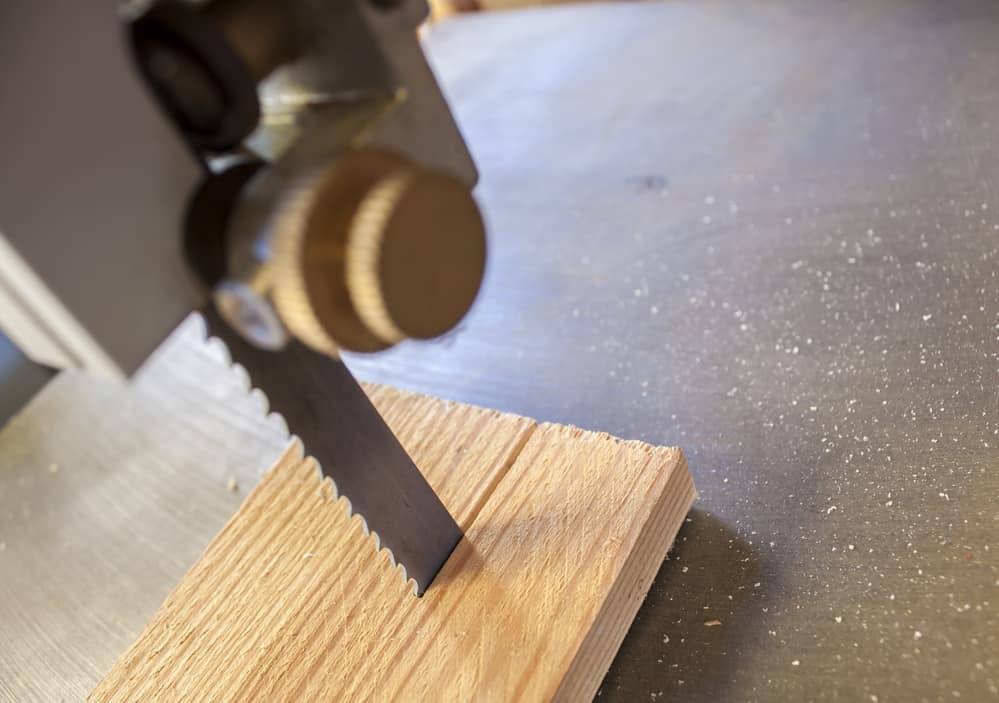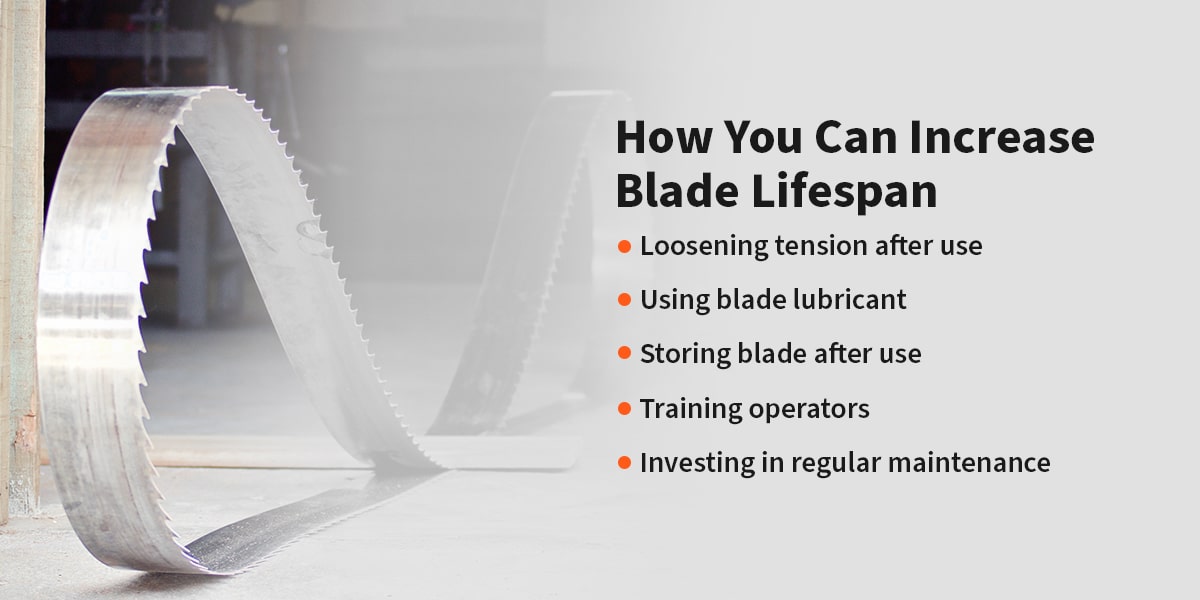If you’re a budding woodworker or just curious about bandsaw blades, you’re probably wondering, “how long should a bandsaw blade last?” Well, you’ve come to the right place! In this article, we’ll dive into the fascinating world of bandsaw blades and explore just how long you can expect them to stay sharp and in good working condition. So, let’s get started on this exciting journey of discovery!
Now, bandsaw blades are like superheroes of the woodworking world, slicing through wood with precision and power. But even superheroes have their limits. The lifespan of a bandsaw blade depends on various factors, such as the type of blade, the materials you’re cutting, and the intensity of your work. Don’t worry; we’ll break it all down for you in simple terms.
So, whether you’re a seasoned woodworker or just starting out, understanding how long a bandsaw blade will last is essential for optimizing your woodworking projects and keeping your cuts smooth and precise. So, sit back, relax, and let’s uncover the secrets behind the longevity of bandsaw blades!
How Long Should a Bandsaw Blade Last?
A bandsaw blade’s lifespan depends on several factors, such as the type of material being cut, the intensity of use, and maintenance practices. On average, a high-quality bandsaw blade can last between 10 to 20 hours of cutting time. However, regular maintenance, such as proper tensioning and keeping the blade clean, can extend its lifespan. It’s important to monitor the blade for signs of wear, like dull teeth or cracks, and replace it when necessary.

How Long Should a Bandsaw Blade Last?
A bandsaw blade is an essential tool for woodworking and metalworking. It is responsible for making clean and precise cuts, allowing artisans to bring their creative visions to life. However, like any tool, bandsaw blades have a limited lifespan. Understanding how long a bandsaw blade should last is crucial for efficient and cost-effective operation. In this article, we will explore the factors that affect the lifespan of a bandsaw blade and provide tips on how to extend its longevity.
The Importance of Proper Blade Selection
The choice of bandsaw blade plays a significant role in determining its lifespan. There are various factors to consider when selecting a blade, such as the type of material being cut, the thickness of the material, and the desired cut quality. Using the wrong blade for a particular application can lead to premature wear and damage. It is essential to match the blade’s teeth per inch (TPI) to the material being cut and ensure it is suitable for the desired cut type, whether it’s ripping, resawing, or contouring. A proper blade selection helps optimize performance and prolong blade life.
Factors Affecting Bandsaw Blade Lifespan
Several factors come into play when determining the lifespan of a bandsaw blade. Let’s explore the key aspects that influence how long a blade will last:
1. Material being cut:
The type of material being cut has a significant impact on a bandsaw blade’s lifespan. Cutting softer materials like wood or plastic is generally less demanding on the blade and can lead to a longer lifespan. On the other hand, cutting tougher materials, such as metals or hardwoods, can cause the blade to wear out more quickly. It is crucial to choose a blade specifically designed for the material being cut to balance cutting efficiency and blade longevity.
2. Blade tension:
Proper blade tension is vital for achieving accurate cuts and optimizing blade life. Insufficient tension can cause the blade to wander, leading to premature wear and poor cutting performance. Conversely, excessive tension can result in blade fatigue and breakage. It is essential to follow the manufacturer’s guidelines and ensure the blade is properly tensioned before use.
3. Blade maintenance and care:
Regular maintenance and proper care can significantly extend the lifespan of a bandsaw blade. It is essential to keep the blade clean and free from debris that can cause friction and premature wear. Lubrication also plays a crucial role in reducing heat buildup and preventing rust. Additionally, maintaining sharp teeth through regular sharpening or replacement is necessary for ensuring clean and efficient cuts while maximizing blade life.
4. Feed rate and cutting technique:
The feed rate at which the material is fed into the blade, along with the cutting technique employed, can impact the blade’s lifespan. Feeding material too quickly can overload the blade, causing it to heat up and wear out faster. Conversely, feeding material too slowly can lead to excessive heat buildup, which can also damage the blade. Finding the optimal feed rate and using proper cutting techniques, such as controlling the downward force and avoiding excessive lateral pressure, can help prolong the life of the bandsaw blade.
5. Blade quality:
The quality of the bandsaw blade itself is a crucial factor in determining its lifespan. High-quality blades are manufactured with superior materials and undergo precise heat treatment processes, resulting in longer-lasting and more durable blades. Investing in a reputable brand and quality blades can save costs in the long run by reducing the frequency of blade replacements.
Extending the Lifespan of a Bandsaw Blade
Now that we have discussed the factors that influence the lifespan of a bandsaw blade, let’s explore some tips to help extend its longevity:
1. Choose the right blade for the job:
Ensure you select a blade that is suitable for the material being cut and the desired cut type. Using the wrong blade can lead to premature wear and damage.
2. Maintain proper blade tension:
Regularly check and adjust the blade tension according to the manufacturer’s guidelines. Proper tension helps optimize cutting performance and prolong blade life.
3. Keep the blade clean:
Remove debris and buildup from the blade after each use. A clean blade reduces friction and prevents premature wear. Use an appropriate cleaning solution and a soft brush to clean the blade.
4. Lubricate the blade:
Apply a suitable lubricant to the blade during use to reduce heat buildup and prevent rust. This helps extend the life of the blade and ensures smooth cutting.
5. Optimize feed rate and cutting technique:
Find the optimal feed rate for the material being cut and use proper cutting techniques to avoid excessive strain on the blade. This helps prevent premature wear and enables clean and efficient cuts.
6. Sharpen or replace the blade when necessary:
Maintain sharp teeth by regularly sharpening or replacing the blade. Dull teeth can cause excessive heat buildup and poor cutting performance, reducing the blade’s lifespan. Follow the manufacturer’s recommendations for sharpening or replacing the blade.
7. Store the blade properly:
When the bandsaw blade is not in use, it is important to store it properly to prevent damage. Coil the blade neatly and store it in a clean and dry environment to avoid rust or other forms of deterioration.
Conclusion
The lifespan of a bandsaw blade depends on various factors such as the material being cut, blade tension, maintenance, and cutting techniques. By choosing the right blade, maintaining proper tension, keeping it clean and lubricated, optimizing feed rate and cutting technique, and sharpening or replacing the blade when necessary, artisans can prolong the life of their bandsaw blades. Following these tips will not only help save costs but also ensure clean and precise cuts for a successful woodworking or metalworking project.
Key Takeaways: How Long Should a Bandsaw Blade Last?
- A bandsaw blade can last anywhere from a few weeks to a few months, depending on various factors such as usage, cutting materials, and maintenance.
- Regular inspection of the bandsaw blade for signs of wear, such as dullness or teeth damage, can help determine if it needs to be replaced.
- Proper blade tensioning and alignment are crucial for extending the lifespan of a bandsaw blade.
- Using the appropriate cutting speed for the material being cut can help prevent premature blade wear.
- Regular cleaning and lubrication of the bandsaw blade can also contribute to its longevity.
Frequently Asked Questions
When it comes to bandsaw blades, understanding their lifespan is important for efficient woodworking. Here are some common questions about how long bandsaw blades should last.
1. How often should I replace my bandsaw blade?
The lifespan of a bandsaw blade depends on several factors: the type of material you are cutting, the intensity of use, and the overall quality of the blade. On average, a bandsaw blade can last anywhere from a few weeks to a few months.
To determine if it’s time to replace your blade, keep an eye out for signs of wear and tear, such as dull teeth, missing or broken teeth, or a significant decrease in cutting performance. Regularly inspecting your blade and staying attentive to its condition will help you know when it’s time for a replacement.
2. Are there any tips to extend the lifespan of my bandsaw blade?
Absolutely! There are a few ways to maximize the lifespan of your bandsaw blade. First, always choose the right blade for the task at hand. Using the appropriate blade for the material being cut will reduce strain on the blade and extend its life.
Other tips include using the correct tension on the blade, ensuring it is properly aligned, and using an appropriate feed rate. Lubricating the blade with cutting fluid or wax can also help reduce friction and prolong its lifespan. Remember to also clean and maintain your bandsaw regularly to keep the blade in top condition.
3. Can a dull blade be sharpened or should I replace it?
While some types of blades can be sharpened, most bandsaw blades are not designed to be sharpened. When a bandsaw blade becomes dull, it is generally more cost-effective and efficient to replace it rather than attempting to sharpen it. Sharpening bandsaw blades requires specific equipment and skills.
If you notice a dull blade, it is advisable to replace it with a new one. This ensures optimal cutting performance and reduces the risk of damaging your workpiece. Remember to follow manufacturer guidelines for blade replacement and disposal.
4. Is blade breakage a common occurrence?
Blade breakage can happen, but with proper care and usage, it shouldn’t be a frequent occurrence. Blade breakage is often caused by factors such as improper tension, incorrect feed rate, or using the wrong type of blade for the task. A dull or damaged blade can also increase the likelihood of breakage.
To prevent blade breakage, make sure to use the appropriate blade for the material being cut and adjust the tension and feed rate accordingly. Regularly inspect your blade for any signs of wear or damage and replace it as needed. Proper maintenance and care of your bandsaw can significantly reduce the risk of blade breakage.
5. Can a bandsaw blade last longer with periodic maintenance?
Yes, regular maintenance can help extend the lifespan of your bandsaw blade. Cleaning the blade after each use to remove any sawdust or debris is essential. This helps prevent buildup, which can negatively impact the blade’s performance.
Furthermore, maintaining proper tension and alignment, lubricating the blade, and taking care to avoid overheating during prolonged use are all important maintenance practices. By following these maintenance steps, you can help your bandsaw blade last longer and continue to deliver optimal cutting results.

Summary
So, let’s sum it up! A bandsaw blade usually lasts for a couple of months, depending on how often you use it and what materials you cut. It’s important to keep the blade clean and sharp for better performance. Remember, if you notice any signs of wear or damage, it’s time to replace the blade.
In conclusion, bandsaw blades have a limited lifespan, but proper maintenance can help them last longer. Don’t forget to take care of your blade, and it will serve you well!
